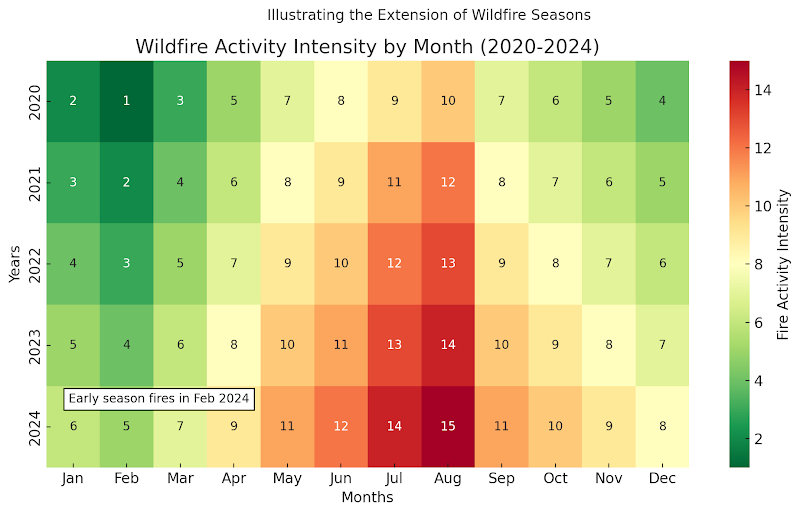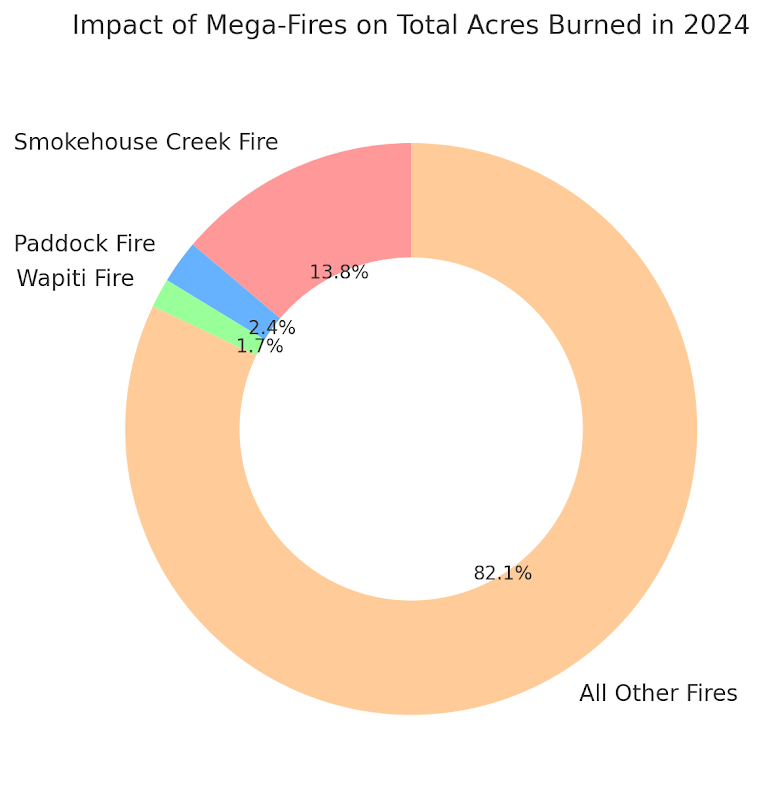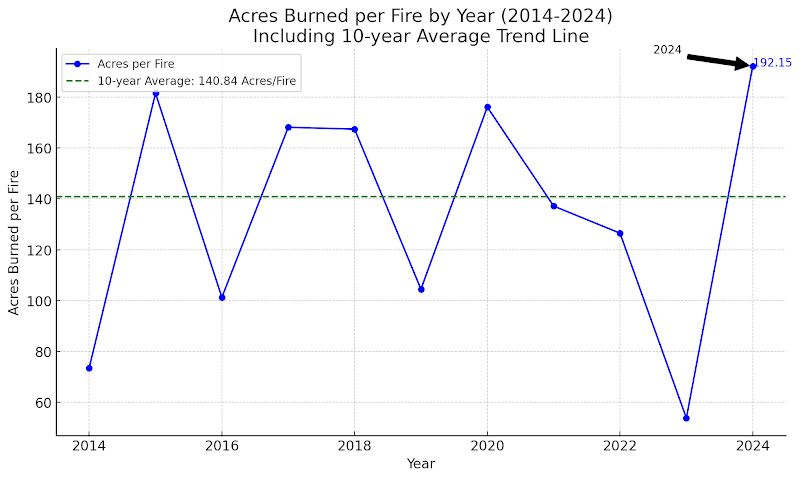Flames of Change: An In-Depth Analysis of the 2024 U.S. Wildfire Season
October 8, 2024
Joel Efosa
Joel efosa is an experienced NATIONWIDE fire damage real estate investor. As owner of fire cash buyer, my goal is to provide fire victims with more options wether its rehab, sell or financial help.
He’s been featured on multiple publications including
Realtor, Yahoo Finance, Business Insider, Nasdaq, MSN, Fox, Go Banking Rates, Homelight
At Fire Cash Buyer, we promote strict editorial integrity in each of our posts.
Table of Contents
2. Intensifying Wildfires Despite Fewer Occurrences
2.1. Quantitative Analysis of Wildfire Data
Table 1: Comparison of Wildfire Data
2.2. Shift in Fire Characteristics
Common Characteristics of Mega-Fires
Impact on Firefighting Efforts
3. Extended Wildfire Seasons: Year-Round Risk
3.1. Time-Series Analysis of Fire Occurrences
Implications for Annual Planning
3.2. Implications of Extended Seasons
Strain on Firefighting Resources
4. Disproportionate Impact of Mega-Fires
4.1. Case Studies of Major Fires
4.2. Strategies for Managing Mega-Fires
5. Climate Change Correlation with Wildfire Activity
5.1. Environmental Factors Influencing Wildfires
5.2. Strategic Planning in the Context of Climate Change
6. Human-Caused Fires and Prevention Strategies
6.1. Analysis of Human-Caused Wildfires
6.2. Education and Policy Interventions
7.2. Recommendations for Future Actions
Executive Summary
The 2024 wildfire season in the United States marked a significant shift in wildfire dynamics, characterized by fewer fires but more expansive and intense blazes.
As of October 8, 2024, there were 39,803 wildfires reported nationwide, below the 10-year average of 46,409 wildfires [1]. However, the total acreage burned soared to 7,748,221 acres, exceeding the 10-year average of 6,788,300 acres by over 1 million acres [1]. This discrepancy indicates a trend toward larger and more severe wildfires.
Key findings include:
- Intensifying Wildfires: Despite a decrease in the number of fires, the total area burned increased significantly, suggesting that individual fires are becoming larger and more destructive [1].
- Extended Wildfire Season: The wildfire season has extended, with fires starting earlier and lasting longer, reshaping annual risk assessments and necessitating year-round preparedness [2].
- Impact of Mega-Fires: Large-scale fires, such as the Smokehouse Creek Fire in Texas, which burned 1,058,482 acres, contributed disproportionately to the total acreage burned and presented significant containment challenges [3].
- Climate Change Correlation: Climate change is linked to the increased frequency and intensity of wildfires due to warmer, drier conditions, emphasizing the need for climate-adaptive strategies [4].
- Human-Caused Fires: Human activities remain a significant ignition source, highlighting the need for enhanced public education and policy interventions to mitigate preventable fires [5].
Implications:
These findings underscore the urgent need for strategic planning and interventions in wildfire management, policy development, and community engagement.
A concerted effort is required to address the escalating challenges posed by wildfires, with an emphasis on integrating climate considerations, enhancing firefighting strategies, and implementing effective prevention measures.
1. Introduction
1.1. Background and Context
Wildfires have long been an integral yet destructive element of the United States' natural landscape. Over recent decades, there has been a notable upward trend in the total acres burned by wildfires [2].
All ten years with the largest acreage burned nationally have occurred since 2004 [2], indicating an evolving wildfire paradigm characterized by increased intensity and frequency.
The analysis of the 2024 wildfire season is vital in understanding these changes. By examining both historical trends and current data, this report aims to illuminate the factors contributing to the intensification of wildfires and the extension of the wildfire season.
1.2. Objectives of the Report
The primary objectives of this report are to:
- Analyze Data: Combine quantitative and qualitative analyses of the 2024 wildfire season to provide a comprehensive understanding of wildfire activity.
- Uncover Trends: Identify significant trends, such as the shift toward larger fires and the extension of the wildfire season.
- Provide Strategic Insights: Offer evidence-based recommendations to inform disaster management strategies and policy decisions.
By fulfilling these objectives, the report endeavors to inform stakeholders, including policymakers, environmental scientists, emergency responders, and the general public, facilitating informed decision-making and proactive wildfire management.
2. Intensifying Wildfires Despite Fewer Occurrences
2.1. Quantitative Analysis of Wildfire Data
The 2024 data presents a paradox: while the number of wildfires decreased, the total acreage burned increased substantially. Specifically, there were 39,803 wildfires reported, below the 10-year average of 46,409 [1], yet these fires consumed 7,748,221 acres, surpassing the 10-year average of 6,788,300 acres by over 1 million acres [1].
Table 1: Comparison of Wildfire Data
| Statistic | 2024 Value | 10-Year Average |
|---|---|---|
| Number of Wildfires | 39,803 | 46,409 |
| Total Acres Burned | 7,748,221 | 6,788,300 |
In California, the mean acres burned per fire was approximately 152 acres/fire, indicating a severity comparable to previous high-impact seasons [6]. This data suggests a trend toward fewer but more severe fires.
Implications:
- Resource Allocation: Larger fires require more extensive resources for containment and management.
- Fire Management Strategies: Traditional approaches may need to be reevaluated to address the increased intensity of wildfires.
2.2. Shift in Fire Characteristics
The nature of wildfires is shifting, with a tendency toward larger and more intense fires. The Smokehouse Creek Fire in Texas exemplifies this trend, having burned 1,058,482 acres and becoming the second-largest fire in U.S. history since 1988 [3].
Case Studies:
Smokehouse Creek Fire, Texas:
- Acreage Burned: 1,058,482 acres
- Containment Date: March 16, 2024
- Casualties: 2 deaths
- [3]
Paddock Fire, Idaho:
- Acreage Burned: 187,185 acres
- [7]
Common Characteristics of Mega-Fires:
- Rapid spread due to dry conditions and high winds.
- Difficult terrain hindering containment efforts.
- Significant resource demands.
Impact on Firefighting Efforts:
- Increased Complexity: Mega-fires present unique challenges that strain existing firefighting tactics.
- Safety Risks: Higher risks to firefighting personnel and affected communities.
3. Extended Wildfire Seasons: Year-Round Risk
3.1. Time-Series Analysis of Fire Occurrences
The wildfire season in the U.S. has traditionally peaked between June and September [2]. However, data indicates that the 2024 wildfire season extended beyond these months, with fires starting earlier and persisting later into the year.

Notable Early Ignitions:
Shift in Seasonal Patterns:
- Fires now occur during months previously considered low-risk.
- The peak wildfire activity has shifted earlier over the years [2].
Implications for Annual Planning:
- Resource Management: Extended seasons demand a reevaluation of resource allocation throughout the year.
- Preparedness: Emergency services must adopt a year-round state of readiness.
3.2. Implications of Extended Seasons
The prolongation of the wildfire season has significant effects on various sectors.
Impact on Industries:
- Agriculture: Increased risk to crops and livestock over a more extended period.
- Tourism: Prolonged fire activity can deter visitors, affecting local economies.
- Insurance: Adjustments in risk assessments and premiums due to extended exposure to wildfire risks.
Strain on Firefighting Resources:
- Personnel Fatigue: Longer seasons contribute to burnout among firefighting personnel.
- Equipment Wear: Increased use leads to higher maintenance costs and the need for more frequent replacements.
- Budgeting: Allocation of funds must account for extended operational periods.
- Training: Continuous training programs to ensure readiness and effectiveness.
4. Disproportionate Impact of Mega-Fires
4.1. Case Studies of Major Fires
Mega-fires in 2024 have disproportionately increased the total acreage burned.
Significant Mega-Fires:

Smokehouse Creek Fire, Texas:
- Acreage Burned: 1,058,482 acres
- Casualties: 2 deaths
- [3]
Paddock Fire, Idaho:
- Acreage Burned: 187,185 acres
- [7]
Wapiti Fire, Idaho:
- Acreage Burned: 126,817 acres
- [7]
Characteristics of Mega-Fires:
- Scale: Vast areas burned, affecting multiple ecosystems.
- Duration: Extended periods to achieve containment.
- Intensity: Higher heat output, making suppression efforts more difficult.
4.2. Strategies for Managing Mega-Fires
Effective management of mega-fires requires specialized strategies.
Current Approaches:
- Advanced Technologies: Deployment of satellite imagery and drones for monitoring.
- Rapid Resource Deployment: Mobilization of firefighting units and equipment to critical areas swiftly.
Recommendations:
- Enhanced Collaboration: Improved coordination across federal, state, and local agencies.
- Community Involvement: Engaging local communities in preparedness and mitigation efforts.
- Investment in Research: Supporting studies on fire behavior and suppression technologies.
Comparative Analysis:
- Regions utilizing proactive measures, such as controlled burns and vegetation management, have shown resilience against mega-fires.
- The effectiveness of rapid response teams highlights the importance of preparedness and resource availability.
5. Climate Change Correlation with Wildfire Activity
5.1. Environmental Factors Influencing Wildfires
Climate change is a critical factor influencing the frequency and severity of wildfires.
Contributing Factors:
- Warmer Temperatures: Lead to drier conditions and increased fuel flammability [4].
- Prolonged Droughts: Reduce moisture in vegetation, making it more susceptible to ignition [1].
- Extreme Weather Events: Increased frequency of heatwaves and lightning storms.
Data Correlations:
- The occurrence of the largest acreage burned aligns with periods of significant climatic shifts since 2004 [2].
5.2. Strategic Planning in the Context of Climate Change
Incorporating climate considerations into wildfire management is imperative.
Climate-Adaptive Strategies:
- Predictive Modeling: Utilizing climate data to forecast fire behavior and spread.
- Sustainable Practices: Implementing land management techniques that reduce vulnerability to fires.
- Infrastructure Resilience: Enhancing the fire resistance of buildings and critical infrastructure.
Policy Initiatives:
- Regulatory Measures: Enforcing environmental regulations that mitigate climate change effects.
- Funding: Allocating resources toward climate adaptation and wildfire prevention programs.
- Public Awareness: Educating communities about the link between climate change and wildfire risks.
Comparative Analysis:
- Regions adopting climate-adaptive strategies have shown improved outcomes in wildfire management.
- Traditional strategies may be insufficient in the face of changing climatic conditions.
6. Human-Caused Fires and Prevention Strategies
6.1. Analysis of Human-Caused Wildfires
Human activities continue to be a prominent cause of wildfires.
Statistics:
- A significant proportion of wildfires are attributed to human actions, including arson and negligence [5].
Notable Incidents in Arizona:
- Boulder View Fire
- Watch Fire (Suspected arson)
- [5]
Impact:
- Human-caused fires often occur in proximity to populated areas, increasing the potential for damage and casualties.
- They add to the burden on firefighting resources already stretched by natural wildfires.
6.2. Education and Policy Interventions
Preventing human-caused fires requires a combination of education and regulatory measures.
Public Education Initiatives:
- Awareness Campaigns: Informing the public about fire risks and safe practices.
- Community Programs: Encouraging local participation in fire prevention efforts.
Policy Measures:
- Legislation: Implementing laws that deter negligent behavior and penalize arson.
- Regulations: Enforcing restrictions on activities that pose fire risks during high-risk periods.
Public-Private Partnerships:
- Collaborations aimed at funding and promoting fire prevention education [[7](Strategic Insights)].
Effectiveness:
- Regions with comprehensive education and policy programs have seen reductions in human-caused wildfires.
- Tailored interventions are more successful when addressing specific regional challenges.
7. Conclusion
7.1. Summary of Key Findings
The 2024 U.S. wildfire season underscores several critical trends:
- Intensified Wildfires: Larger and more severe fires despite fewer occurrences [1].
- Extended Fire Season: The wildfire season has lengthened, requiring adjustments in preparedness and resource management [2].
- Mega-Fire Dominance: A small number of large fires contributed disproportionately to the total acreage burned [3].
- Climate Change Influence: Climate change plays a significant role in exacerbating wildfire conditions [4].
- Human Factors: Human-caused fires remain a preventable contributor to wildfire incidents [5].
7.2. Recommendations for Future Actions
To mitigate the escalating wildfire risks, the following actions are recommended:
- Integrate Climate Data: Incorporate climate projections into wildfire planning and management.
- Enhance Mega-Fire Strategies: Develop specialized tactics for preventing and containing large-scale fires.
- Adjust Preparedness Plans: Adapt to the extended wildfire season with year-round readiness.
- Strengthen Education Programs: Intensify public education to reduce human-caused ignitions.
- Implement Policy Changes: Enact and enforce policies aimed at prevention and effective response.
Collaboration among stakeholders is essential to implement these recommendations successfully. A concerted effort will enhance resilience against wildfires and protect communities and ecosystems.
Appendices
A. Data Sources and Methodology
Data Sources:
1. National Interagency Fire Center
- Title: Fire Information - National Fire News
- URL: https://www.nifc.gov/fire-information/nfn
2. Environmental Protection Agency
- Title: Climate Change Indicators: Wildfires
- URL: https://www.epa.gov/climate-indicators/climate-change-indicators-wildfires
3. Wikipedia
- Title: 2024 Texas Wildfires
- URL: https://en.wikipedia.org/wiki/2024_Texas_wildfires
4. National Oceanic and Atmospheric Administration
- Title: Wildfire Climate Connection
- URL: https://www.noaa.gov/noaa-wildfire/wildfire-climate-connection
5. Wikipedia
- Title: 2024 Arizona Wildfires
- URL: https://en.wikipedia.org/wiki/2024_Arizona_wildfires
6. Wikipedia
- Title: 2024 California Wildfires
- URL: https://en.wikipedia.org/wiki/2024_California_wildfires
7. Wikipedia
- Title: 2024 Colorado Wildfires
- URL: https://en.wikipedia.org/wiki/2024_Colorado_wildfires
Methodology:
- Data Collection: Compiled from official reports and credible online sources.
- Quantitative Analysis: Examined statistical data on fire occurrences and acreage burned.
- Qualitative Analysis: Reviewed case studies and narrative accounts of significant fires.
- Comparative Analysis: Compared data across different years and regions to identify trends.
B. Glossary of Terms
- Acre: A unit of area equal to 4,840 square yards or 43,560 square feet.
- Containment: The process of controlling a wildfire so it does not spread.
- Mega-Fire: An exceptionally large wildfire that poses significant challenges in containment.
- Wildfire Season: The period when wildfires are most likely to occur.
- Ignition: The initiation of combustion leading to a fire.
- Climate-Adaptive Strategies: Approaches that incorporate climate change considerations into planning.
- Controlled Burn: A fire set intentionally for forest management, farming, or ecological purposes.
- Drought: An extended period of deficient rainfall relative to the statistical average.
References
| Reference Number | Author/Organization | Title | URL |
|---|---|---|---|
| [1] | National Interagency Fire Center | Fire Information - National Fire News | https://www.nifc.gov/fire-information/nfn |
| [2] | Environmental Protection Agency | Climate Change Indicators: Wildfires | https://www.epa.gov/climate-indicators/climate-change-indicators-wildfires |
| [3] | Wikipedia | 2024 Texas Wildfires | https://en.wikipedia.org/wiki/2024_Texas_wildfires |
| [4] | National Oceanic and Atmospheric Administration | Wildfire Climate Connection | https://www.noaa.gov/noaa-wildfire/wildfire-climate-connection |
| [5] | Wikipedia | 2024 Arizona Wildfires | https://en.wikipedia.org/wiki/2024_Arizona_wildfires |
| [6] | Wikipedia | 2024 California Wildfires | https://en.wikipedia.org/wiki/2024_California_wildfires |
| [7] | Wikipedia | 2024 Colorado Wildfires | https://en.wikipedia.org/wiki/2024_Colorado_wildfires |


